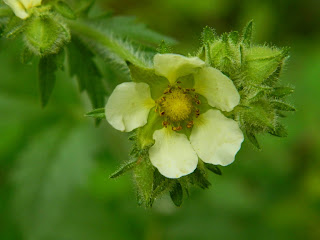Today I thought I'd share with you about an early abundant spring plant that can be used for food.
Sulphur cinquefoil (Potentilla recta)
In our fields it is everywhere! Below is a quick guide to recognising it, as well as some uses.
Flower- note the heart-shaped petals in two tones of yellowSulphur Cinquefoil
Potentilla recta
Rosaceae
Synonyms:
Description: Perennial herb that can grow up to 80cm tall. Likes to grow in open fields.
Leaves are palmately divided into 5-7 deeply toothed and veined leaflets. The name cinquefoil, which means five leaf or five petal refers either to the five petaled flower or to the five leaflets that are arranged like fingers on a hand. Some people think that the leaves resemble marijuana leaves. Most sulphur cinquefoil have seven leaflets at maturity, but some have five. They are dark matte-green on top and pale below. The leaves form a basal rosette as well as forming an alternate pattern up the stalk. At each petiole there are two jagged stipules attached to the stalk.
Stalk is woody and green/yellow. Both the leaves and stalk are covered in soft hairs.
Flower is yellow in two tones, light yellow on petals and dark yellow towards the centre. It has five petals, each shaped like a heart. Flowers grow in flat topped clusters (cyme). Early in the morning the flowers are not yet opened; they open as the day progresses.
Fruit is small and strawberry-looking and enclosed within a papery husk. This husk turns brown and dries in late summer. Inside are many small seeds that fall out once the husks dry up and open. The seeds are dark brown and wedged-shaped.
Tap root is fibrous and woody.
Husk and seeds in August
Uses:
This species is an introduced variety that can become quite widespread. The leaves, in early spring, or when they are immature, can be picked and added to any meal you cook. They are not suitable raw in a salad due to their texture and the fine hairs on the leaves. However, the dried leaves can be added to bread and muffins. They dry fast and are easy to crumble up. Their flavour is similar to strawberry leaves (Fragaria spp) or rose leaves (Rosa spp): Fresh, sour and drying. They are all part of the same family, Rosaceae.
The leaves can also be used medicinally whenever an astringent is called for. The astringency in the plant helps to tighten the skin and heal wounds. I have used it with great success when I have bit the inside of my cheek and the puncture wound has become infected. I make an infusion or decoction of the fresh plant, stalk, leaves and flowers. I gargle with this liquid three times per day until I see an effect. After using it for only a day I can already see a marked improvement and the pain is almost all gone. A tea made from the leaves can also be drunk if you are suffering from diarrhea.
Many people complain about sulphur cinquefoil due to its invasive tendencies and how it can make hay of inferior quality when it gets into the hay fields. We have found that the sulphur cinquefoil thrives in pastures with poor fertilizing and low irrigation. Here on the farm we run chickens in large movable tractors over parts of the fields and it seems as if the cinquefoil is kept in check where the chickens have been able to scratch and poop. Where they have not been, the land is much drier and has less grass and more cinquefoil. The hay from the pasture with the cinquefoil is popular with goat owners.
Look-alikes:
There are many different kinds of cinquefoil and they can be hard to tell apart. Below are just a few examples.
Graceful Cinquefoil (Potentilla gracilis) is a native species. The flowers tend be one-toned rather than two-toned in colour. Leaves are more finely divided and are more likely to be in a basal rosette rather than on stem. This plant can be used in the same manner as sulphur cinquefoil.
Sticky cinquefoil (Potentilla glandulosa). As the name implies, it has sticky glands. Flower petals are rounded rather than heart shaped. Sepals are very prominent. Also edible. See picture below.
Tomentil/Erect Cinquefoil (Potentilla recta) See caution below!
Caution
Note that there are two species with the same common name and almost identical Latin names. Sulphur cinquefoil/ Erect cinquefoil (Potentilla recta) that we speak of here, (an introduced species from Eurasia) and Tomentil/ Erect cinquefoil (Potentilla erecta) that grows in Europe. Tomentil can not be eaten as food but has been used for medicine. Any amount over 1g can cause gastrointestinal problems and issues with absorption of minerals and iron in diet. I have not seen Tomentil here, but it may be around. An easy way to tell them apart is by the flower petals. Sulphur cinquefoil has five petals, Tomentil has four.
Sticky cinquefoil (Potentilla glandulosa)







No comments:
Post a Comment